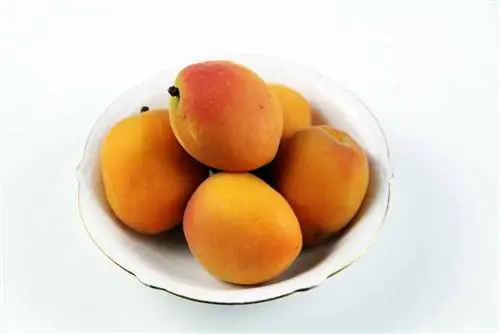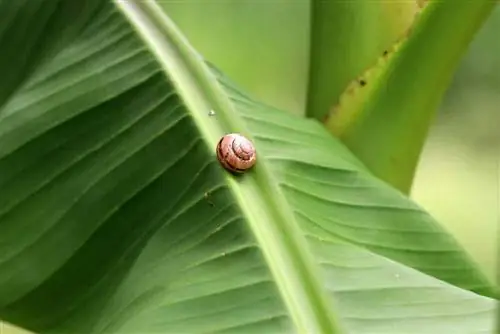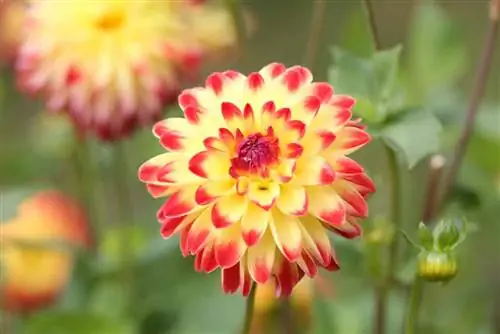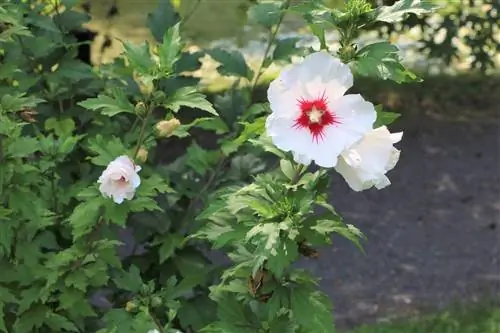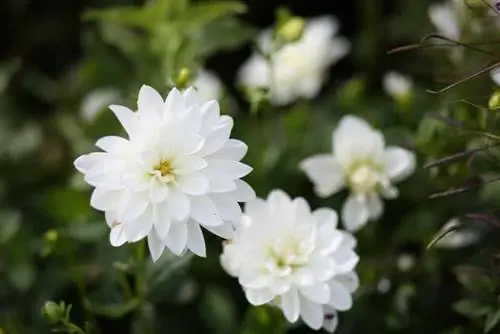- Author admin [email protected].
- Public 2023-12-17 03:39.
- Last modified 2025-01-24 12:45.
The varied perennial flowers can be planted outdoors or can develop their full splendor in a pot.
Planting dahlias outdoors
The ideal planting time for dahlia tubers is early to late April. It is important that night frost no longer penetrates the soil. If frost is imminent, it is advisable to cover the plants that have already sprouted. Before the dahlia tubers are planted, they should be placed in water for a day before being placed about a hand's width deep into the soil. When planting, compost, bone or horn meal and horn shavings should also be added immediately. When planting, support rods should be placed next to the tubers. The plants should be tied every three weeks to prevent them from falling apart. Dahlias are not hardy, so they have to be dug up again every autumn. The plants can be planted again next spring. Tubers that have become too large can easily be divided. The tuber can be cut into several parts with a sharp knife.
Planting dahlias in pots
The culture is also suitable for planting in containers. The pot dahlias are planted at the same time as the free dahlias. The tubers should be planted approx. 10 cm deep. It is important to ensure that the diameter of the container is approximately half the height of the dahlias. In addition, the tubers must not be planted too close together, as this means the foliage grows very tightly and can dry poorly when it is wet. Fungal diseases can result. Excess water should always be able to drain away. Dahlias can be repotted easily. The plant should be generously dug up around the tuber and then planted in another container.
Location, watering and fertilizing
- Dahlias prefer a very sunny location. In the shade they develop very strong stems, but only weak flowers.
- A place protected from the wind is ideal. Under no circumstances should dahlias be planted in front of a wall or a wall that radiates heat.
- The plants do not need a lot of water and tolerate drought excellently.

Nevertheless, you should not wait until the leaves hang limply, as this can cause permanent damage! Dahlias cannot tolerate constant moisture at all. The plants should only be watered if it is persistently dry and hot. It is important to ensure that you always water from below and that the leaves do not get wet. If the dahlia is watered too heavily, the green parts of the plant can become overwhelming and are susceptible to fungal diseases.
- You should only fertilize when the dahlias are planted, otherwise the plants will become too massive and will not have a strong stand.
- The plant should only be fertilized once if the soil is very sandy, as a lot of fertilizer is lost through leaching.
- You should avoid fertilizers rich in minerals and nitrogen, as these ensure very rapid growth but do not give the plant any strength.
Cutting dahlias
Dahlias can bloom until frost. In order to achieve this long flowering period, the dead flowers should be removed regularly. Withered plants are cut off above the next bud so that new flowers are continually formed. At the end of the flowering period, the dahlias are cut down completely (about a hand high above the ground). Dahlias bloom more profusely the more stems with flowers are cut off.
Overwintering dahlias
After the first frost, the dahlia tubers should be dug up. For overwintering, leave approx. 6 cm of stem above the tuber. Under no circumstances should you cut the stems flush, as the eyes of the dahlias come from the stems and not from the tuber. Be careful when digging so that the tubers are not injured! These need to be lightly tapped off. The remaining soil protects the tubers from drying out over the winter.
If temperatures permit, you should let the tubers air dry for a few hours. Wintering should be airy and cool, at around 5 to 7 °C. If the temperatures are higher, you can place the tubers in sawdust or sand and moisten them a little from time to time. It's best to layer the tubers every now and then and check for rot and mold. Under no circumstances should you put them in plastic. The lack of air can cause them to rot. Valuable tubers can be protected from rot by dusting with sulfur.
Caring for Dahlias
The plants are very robust and uncomplicated. In order to bloom properly, the plants should always be adequately supported. If the dahlias fall apart, the flower splendor is quickly over. The plants cannot be left to their own devices. Varieties that grow over 80 cm tall and produce full flowers must be supported extensively. To achieve even larger flowers, all secondary buds must be broken off as soon as the flower buds appear.
Dahlia diseases?
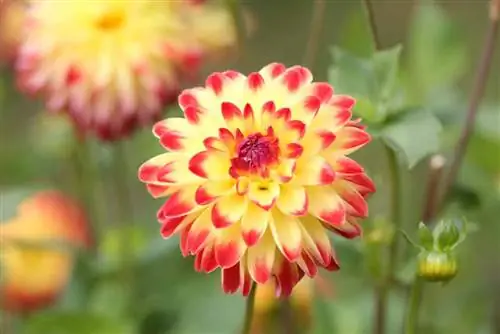
The best protection against disease is a very sunny location. Wetness damages the plant and causes fungal diseases. The only enemy of the plant is the snail, which can, however, be driven away with a slug killer.
Propagation of Dahlias
Dahlias are propagated by division, sowing or cuttings. The tubers can easily be divided before planting. A bud must remain on each tuber. Sowing should take place in March. After just ten days, small seedlings appear that will also bloom in the same year. Cuttings are cut from the tuber. Late January to early February is the ideal time. The cuttings are best grown in a greenhouse. Drafts must be avoided at all costs. You can put the tubers in a box and cover them lightly with some soil. The stem neck must be left free. A temperature of at least 15 °C is required for fresh shoots to form. If the shoots are at least 3 cm tall, they can be plucked off and placed in a box with soil.
Dahlias are easy to care for and delight with their lush flowers. The easy propagation and overwintering ensures magnificent plants until autumn.
What you should know about dahlias in brief
Dahlias require a little more work than other garden plants. They also reward you with particularly beautiful and multicolored flowers.
The flowers love sandy and slightly acidic soil, with a pH value of around 6.5. Clay soil is not suitable, as water drains poorly and waterlogging can occur. A sunny location is ideal.
Planting dahlias
- The best time to plant dahlias is the end of April/beginning of May. The soil should be reasonably dry.
- The dahlias should under no circumstances be planted too deep so that the shoots do not have to struggle upwards.
- Cuttings should only be placed in the garden soil after the Ice Saints.
Tip:
Many dahlia specialists swear that the plants sprout and grow better if the tubers have been in water for two days before planting. Many also grow the tubers in the warm. But that doesn't actually have to be the case. The planting distance should be around 80 cm.
Care instructions
- Dahlias should not be watered in direct sunlight. The leaves burn very quickly when the sun hits adherent water droplets.
- Otherwise the plants need water regularly: it's best to water a little in the morning and evening, that's better than just watering a lot once.
- From the end of September you should water more sparingly to encourage the tuber to store water. This is what she needs for the dahlia to overwinter.
- To ensure that dahlias bloom for a long time, dead flowers must be removed regularly. Seed pods must also be cut off.
Fertilization
- The fertilizer can be added to the planting hole when planting or incorporated into the beds in spring.
- Horn shavings and seasoned and dry cattle dung are well suited. Horse manure is not suitable.
- Fertilizer with a lot of nitrogen only ensures that the plants grow taller. This leads to long and thin shoots


